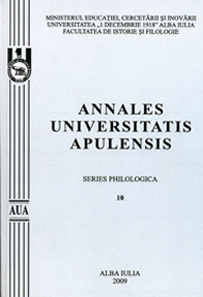WELLS’ SCIENTIFIC ROMANCES - A CLASSIC CASE OF INTERDISCIPLINARITY
WELLS’ SCIENTIFIC ROMANCES - A CLASSIC CASE OF INTERDISCIPLINARITY
Author(s): OTILIA SimionSubject(s): Literary Texts
Published by: Universitatea »1 Decembrie 1918« Alba Iulia
Keywords: scientific; romance; fantastic; vision; imagination; interdisciplinarity
Summary/Abstract: Before 1900 most of Wells’ fiction belonged to a genre which was then called ”scientific romance” and is now simply known as ‘SF’. It was a work written in the age of Edison and Eiffel and greatly indebted to Jules Verne. There had been many Utopian and dystopian predictions at the time such as Edward Bellamy’s Looking Backward (1888) or William Morris’s News from Nowhere but they didn’t have either scientific insight or a gift for anticipation. These qualities had to come with Wells who brought both scientific accuracy and fantasy based on logic in his scientific romances. Wells’ novels written up to the turn of the century prove him to be well read in modern science and in the scientific method acknowledging both the advantages of a scientifically planned future and the antihumanism of certain aspects of scientific progress. All his scientific romances - The Time Machine (1895), The Island of Dr. Moreau (1896), The Invisible Man (1897), The War of the Worlds (1898), The First Men on the Moon (1901) can still be read as alarmist prophecies nowadays. They depict a world where technology changes everything, from the relation of the sexes to space travel, and obviously departs from Old England and the Victorian age. All these novels abound in amazing inventions, machines, scientific discoveries, progress, future wars and, in spite of the fact that they are fantastic tales, they are based on real scientific and military possibilities. They also function as warnings against possible turns: world war, social collapse, racial conflict. Wells himself wrote in A Modern Utopia (1905): “The almost cataclysmic development of new machinery, the discovery of new materials and the appearance of new social possibilities through the pursuit of material science have given enormous and unprecedented facilities to the spirit of innovation”. It is a world of change and innovation in the age of modernization. In The Island of Doctor Moreau, Wells seems to be endowed with the intellectual imagination of a scientific investigator, while in The Time Machine he gave a picture of prophetic visions of the dying earth sometimes fantastic but always logical. In this novel a speculative mechanician discovers that the “fourth dimension “is Time and that man may travel in Time and Space”. The Time-traveller of this story invents a machine by the help of which all that belongs or is affixed to it may pass into the Future or into the Past. Wells considered the scientific spirit to be the driving force of human progress and he became a leading missionary of modern science. He was both a visionary and a teacher and what he taught was the necessity and imminence of social change. Other novels like The Invisible Man and The War of the World are warnings against the perils of exploiting the huge resources of human energy. Wells’ tale is always one of interdisciplinarity.
Journal: Annales Universitatis Apulensis. Series Philologica
- Issue Year: 11/2010
- Issue No: 3
- Page Range: 293-
- Page Count: 11
- Language: English

